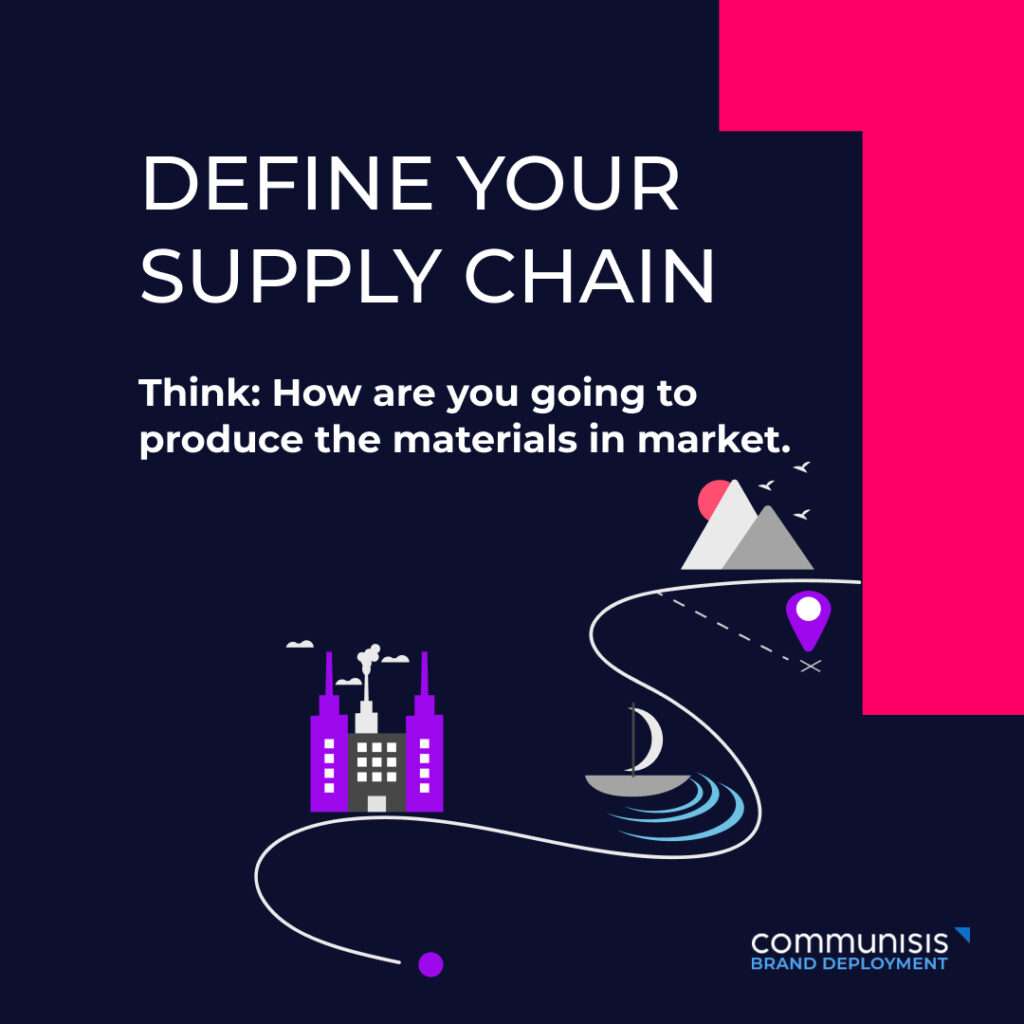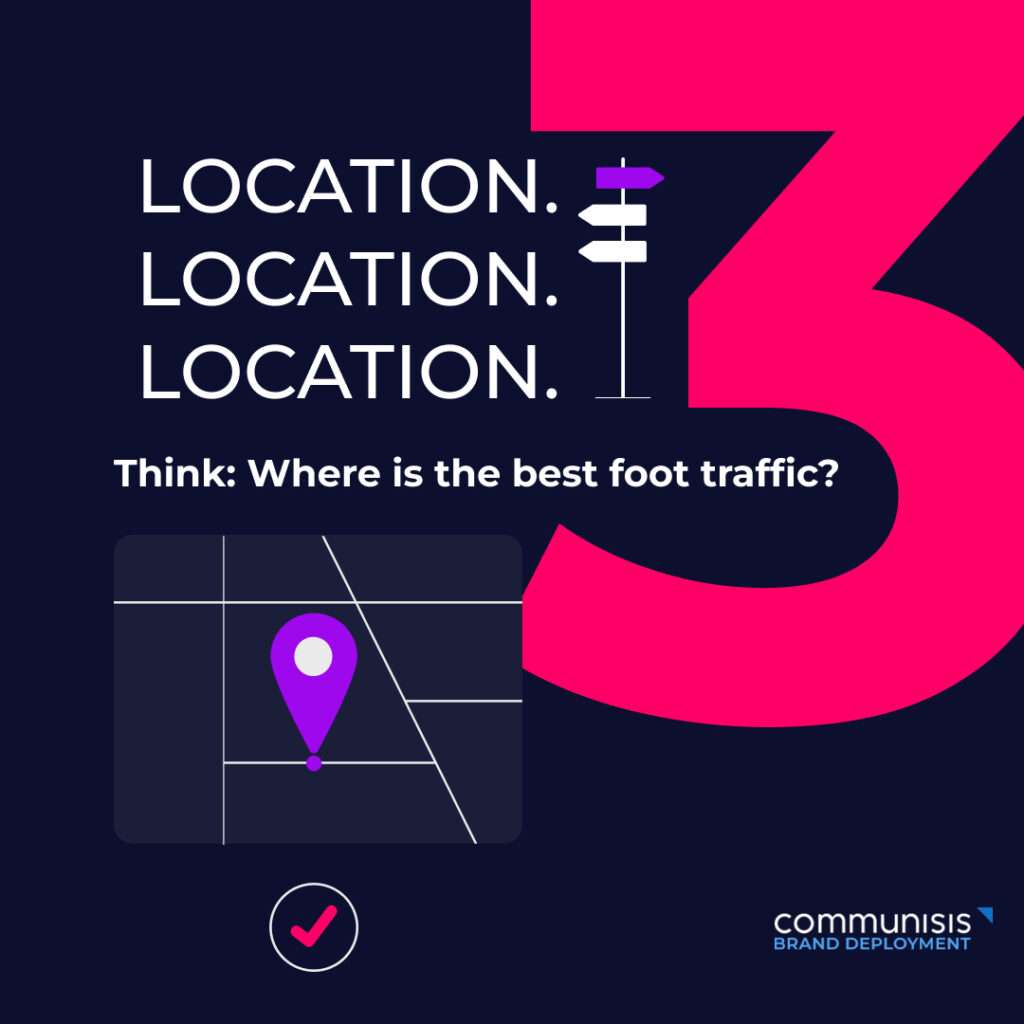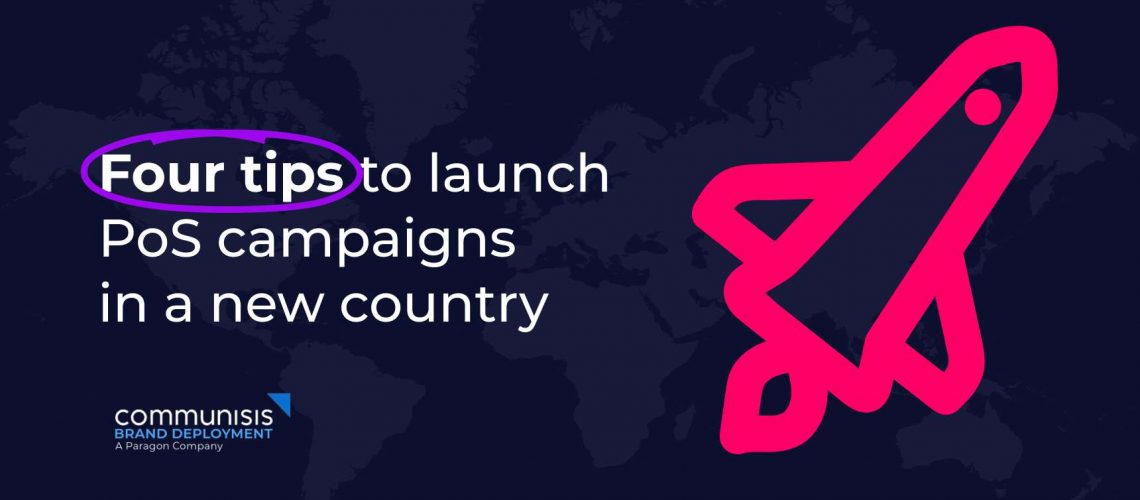Launching Point-of-Sale (PoS) campaigns in new markets can be challenging and complex. You need to know how the local market works. What materials and transport are available? And, how the local requirements and regulations.
When you are a global brand operating in hundreds of countries, it is challenging to ensure brand consistency across every PoS campaign, let alone when launching campaigns in entirely new markets.
With a wealth of experience in launching PoS campaigns across highly regulated Europe, the far reaches and remote locations of Asia, and the glitz and glamour of the US, our team has gained valuable insights. Here are four top tips we’ve learned to consider before launching in a new market.

Tip 1: Define your supply chain
How are you going to produce the materials you need in the market?
Global PoS activations require brand consistency. That means campaigns must look and feel the same no matter what market you are launching in. If you are signalling to your audience that you are a sustainable brand, for example, then all your PoS campaigns must use sustainable materials.
As such, a robust supply chain is the backbone of any successful PoS campaign.
The challenge in defining your supply chain is not all countries have access to the same materials. Even if they do, the costs might be prohibitive due to the material’s availability.
For example, let us say your brand needs to source high-quality recycled polyester for your in-store display. In some markets, you might find local production is limited or has high import duties. Collaborating with a local supplier will enable you to find alternative sustainable materials, like bamboo, or explore options for bulk imports to reduce costs.
Another issue is the quality of materials or production methods might vary. In this instance, it is essential to implement strict quality control measures and establish clear guidelines for material sourcing and production with suppliers.
When launching in a new market, it is critical to understand the supply chain of materials for your campaigns. This understanding is gained through local factory visits, which provide insights into material production and availability. Making these decisions early will ensure long-term success and maintain consistency.
Now, you can set the requirements with your production partners and agree on the materials, quality, and standards that must be adhered to ensure brand consistency.
At Communisis, we have a significant global footprint with over 600 strategic production and supply partners. We understand how it all works and have already set the standards for successful brand deployments, ensuring all materials meet our quality standards. If materials are unavailable, we know what alternatives are or how we can obtain them elsewhere.

Tip 2: Understand your infrastructure needs
How are you getting your materials from point A to point B?
Now that you know what materials can be produced and used in your campaigns, you have to figure out how to transport them across the country.
In remote markets like India or those with vast geographic distribution requirements like Australia, knowing how to get your PoS solutions into stores, is no easy task.
You should consider how to transport your materials and what time frames you might need to consider. You need to analyse the local infrastructure to understand these requirements thoroughly.
Things like: What methods of transportation are available? What routes are available? Will you use distribution centres, and how will you fulfil the last mile?
For example, due to limited road infrastructure and transportation options, you might need help transporting large-format displays to regional stores. Partnering with a local logistics provider specialising in remote area deliveries may unlock alternative methods for larger shipments, such as air or sea freight.
Finding a local partner here can be helpful. A good partner will already have networks available that will help you overcome distribution challenges. Whether getting your materials to remote locations or ensuring materials can get delivered on time, every time.

Tip 3: Location. Location. Location.
Where is the best foot traffic?
You do not want your campaigns to be placed in locations that will never be seen by your desired market. It will be a waste of budget if your PoS campaign is tucked away in the corner of a store or among significant competitor presence.
You also do not want your PoS campaign to be in a geographic area where foot traffic is at a minimum, and sales are hard to come by. For instance, in a neighbourhood where the high street is desolate or provides the wrong signals to your buyer.
While data from retail partners will help make decisions from further afield, nothing beats eyes on the ground and local knowledge.
Visiting the location is essential, but for global brands, this could mean constant travel. So, finding a trusted partner who can report back on your behalf—someone who has boots on the ground and knows the nuances of the local market—is not just important, it is critical. It saves time, resources, and ensures your campaign is in the right place.
A local partner can also prove invaluable when it comes to local regulations and permits for launching PoS campaigns. Each market has its own unique set of rules governing outdoor advertising, in-store displays, and promotional activities. Failure to comply can result in hefty fines, campaign disruptions, or even legal issues. Understanding these regulations, from permit requirements and size restrictions to content guidelines and safety standards, is essential.
It is crucial to allocate sufficient time to research local laws and work with legal experts to ensure full compliance. Or find a partner that knows this information inside and out.

Tip 4: How will you pay?
What are the tax and payment requirements for the new market?
Different countries have different import taxes and payment requirements. Some countries require you to set up a local subsidiary to do business. If you do not, you will likely have to pay import tax to bring your PoS campaigns to market.
To overcome import duties, it might be wise to hire a local customs broker to navigate the import process and minimise costs. Alternatively, you could explore opportunities to manufacture some materials locally to reduce import duties.
In others, payment might only be taken in the local currency, meaning you will need a global payment provider or a local bank account to make the payments.
You will also need to understand the local payment terms to ensure they are favourable to conducting your business in that country. For instance, we often pay for print jobs on a 50:50 principle – 50% of payment upfront and 50% on delivery.
Before entering a new market, it is essential to consider how these will impact how you operate and pay suppliers. Having a partner already in the market who can help you navigate these local complexities can be advantageous to your bottom line, helping to maximise your budgets.
By following these tips and adapting them to the specific nuances of each market, you can increase your chances of launching successful and impactful PoS campaigns. Remember, thorough planning, local partnerships, and a deep understanding of the target market are key to achieving your campaign objectives.


